Serviços Personalizados
Journal
Artigo
Indicadores
-
 Citado por SciELO
Citado por SciELO -
 Acessos
Acessos
Links relacionados
-
 Similares em
SciELO
Similares em
SciELO
Compartilhar
Revista Diacrítica
versão impressa ISSN 0807-8967
Diacrítica vol.26 no.1 Braga 2012
(Ab)normalities in the Acquisition of Cypriot Greek
Natalia Pavlou*; Elena Papadopoulou**
*University of York, Department of Language and Linguistic Science, York, UK.
**University of Essex, Department of Language and Linguistics, Colchester, UK. University of Cyprus, Department of English Studies, Nicosia, CYPRUS.
nataliapavlou@gmail.com; epapadb@gmail.com
ABSTRACT
This paper discusses syntactic errors identified in child speech, which contribute to our understanding of the linguistic development in the first years of our lives. The focus lies on childrens ungrammatical and non-target utterances appearing to violate the Pied-piping condition in D-linked wh-questions as found in two different elicitation experiments. The violation of grammatical constraints, such as the one discussed, supports fundamental notions in language such as Economy and points out the importance of the experimental design for the limitation of these errors. The study more generally concentrates on the understanding of structures that involve Movement as an attempt to understand the specificities in the linguistic development of Greek Cypriot children as well as the stages in the acquisition course involved cross-linguistically. The childrens errors found in both experiments using priming in different degrees strengthen the importance of innately-motivated patterns in language.
1. INTRODUCTION
This paper identifies error patterns in childrens wh-question production as found in two experiments, namely Syntactic Priming Experiment in Cypriot Greek (henceforth, SPE-CG) (Papadopoulou in progress) and Guess What Game (henceforth, GWG) (Pavlou 2012)[1]. Further, it tries to provide a syntactic analysis to account for the errors identified as well as postulates possible theoretical and methodological implications regarding elicitation and wh-question acquisition. 103 and 62 children aged 2;8 - 6;5, and 3;0 - 6;11 participated in SPE-CG and GWG respectively. The two experiments used different degrees of syntactic priming to elicit wh-questions in Cypriot Greek (henceforth, CG), a linguistically understudied variety of Greek spoken in Cyprus specifically in the areas of the island found under the control of the Republic of Cyprus. Cyprus linguistic situation is not easy to define, neither in the areas under the control of the Republic of Cyprus nor in the areas under the control of the Turkish Cypriot pseudostate since the military operations of 1974 (see inter alias Papadopoulou & Pavlou 2010, Leivada, Kambanaros & Grohmann 2012, Papadopoulou, in progress, Rowe & Grohmann 2012).
Cyprus exhibits de jure bilingualism (Greek, Turkish[2]; referring to the standard varieties in both cases) and de facto trilingualism in Greek, Turkish and English (Arvaniti 2002) or bilingualism in Standard Modern Greek (henceforth, SMG) and CG (Newton 1972, Vassiliou 1995) or bidialectism in SMG and CG (e.g., Pavlou & Christodoulou 2001, Yiakoumetti et al. 2005). Whichever the definition used to describe the linguistic situation, the reality is that Cyprus[3] exhibits a bi-x (see Leivada & Grohmann 2010, Grohmann & Leivada 2011, in progress) situation, a term proposed to cover any possible bi-mixing of language-dialect. A recent suggestion describing Cyprus linguistic state of the art has been proposed by Rowe & Grohmann (2012) who suggest the Cypriot society should be characterised as diglossia, moving towards diaglossia, with the Greek Cypriot speakers being bilectal, between CG and SMG; by employing the term (discrete) bilectalism. Acknowledging Cyprus linguistic perplexed situation (see inter alias Grohmann et al. 2006), we try to compare the two experiments on the basis of their different design –different degrees of priming- and results obtained in relation to bi-mixing. The two experiments try to test wh-question and cleft production in CG by young children. As analysed in detail in sections 3.3 and 4.3 the results obtained identify potential wh-movement operation difficulties in child wh-question production which seem to be affected, reinforced and/or weakened by the strength of priming. In SPE-CG, wh-question production is achieved through the employment of the syntactic priming paradigm with full pushing for priming, whereas, GWG is a simple elicitation experiment, which unlike SPE-CG only provides two examples for warm-up[4].
Syntactic priming studies have shown that adults are more likely to use particular target constructions (e.g. passives) if they have just heard a prime sentence with the same construction (Bock, 1986, 1992, Branigan, 2000, 2007). This effect occurred even when sentences contained different lexical material, suggesting that hearing or producing a sentence with a particular syntactic structure activates an abstract syntactic representation of this sentence and hence makes it more accessible for speech production. Children (aged 3;0-6;0) show syntactic priming when the same verb is involved in both prime and target (Huttenlocher et al 2004, 2007, Savage et al 2003). However, it is still debated whether children exhibit syntactic priming (i) when prime and target involve different verbs and (ii) when they only hear the prime, but do not repeat it. In SPE-CG participants were asked to re-produce 5 sentences with the same underlying structure twice, allowing for very strong syntactic priming, whereas in GWG participants were asked to produce questions and clefts with minor priming of two warm ups only. The difference in the degree of the syntactic priming in the two experiments correlates with the amount of errors produced (see section 5 for a detailed discussion).
A brief description of wh-questions in CG, illustrating the existing literature is discussed in Section 2. Sections 3 and 4 present the two experimental methodologies, namely SPE-CG and GWG respectively and a brief summary of similar patterns and studies found cross-linguistically. Section 5 involves the discussion and conclusions deriving from the error analysis of the results obtained. The conclusion focuses on the obvious difference set out from the comparison of the experiments using different degrees of priming and the presentation of a syntactic analysis to account for the childrens errors. Even though D-linking is a complex phenomenon that may involve all components of language, we will mainly focus on the syntactic component in our discussion.
2. CG WH-SYNTAX
Non-echo wh-questions in CG are formed by fronting -movement- of the wh-phrase to the left periphery[5] (1) and (2) below, while rendering ungrammatical wh-subextraction (3).
(1) Ti/Inda mbu  kiavazi o
kiavazi o
what is-(it)-that reading-3SG the-NOM
andras ti/inda mbu?
man-NOM what
What is the man reading?
(2) Pco /Inda vivlion (embu)  kiavazi
kiavazi
which book-ACC is-(it)-that reading-3SG
pco/inda vivlioo andras?
which the-NOM man-NOM
Which book is the man reading?
(3) * Pco /Inda (embu) ?kiavazi pco/inda
which is-(it)-that reading-3SG which
vivlion o andras?
book the-NOM man-NOM
Which book is the man reading?
In this paper we explore syntactic priming effects between three types of questions, namely Non-referential (NR) ti what, inda mbu[6] what is-(it)-that, Referential (R) pco which and inda which questions, as well as inda/inda mbu why(1-2 above and 4 below).
(4) Inda/ Inda mbu klei o
why crying-3SG the-NOM
andras?
man-NOM
Why is the man crying?
As portrayed in examples (1) – (2) above CG questions allow for two similar wh-words/phrases to appear in the same context and question; ti/inda mbu, pco/inda. The first wh-word/phrase is equivalent to respective SMG wh-word/phrase whereas the second is CG-specific. As assumed by Newton (1972) and Arvaniti (2002) CG and SMG wh-production differs not only in the wh-word/phrase employed but rather minor pragmatic-semantic and possibly morpho-phonological differences can be found between the two. Substantial formation differences with respect to the embuis-(it)-that strategy analysed further down and the different wh-words employed can also be found.
A Cypriot-specific element involved in our experiments is inda what/why. Inda what and inda why are invariant in gender, number, and case, with the inda what pronoun used either prenominally (what/which NP) or pronominally (see Pavlou 2010a & Papadopoulou, in progress for further details).
A strategy employed in CG wh-question formation and found in SPE-CG is the so called embu-strategy (Grohmann et al. 2006, Papadopoulou, in progress). The embu-strategy is formed by the addition of the embu element, which can be translated as it-is-that, when following Grohmann et al. (2006) or is-(it)-that following (Papadopoulou, in progress)[7]. Embu optionally appears in questions deriving to examples 5 and 6:
(5) Ti (embu)  kiavazi o
kiavazi o
what is-(it)-that reading-3SG the-NOM
andras?
man-NOM
What is the man reading?
(6) Pco vivlion (embu)  kiavazi
kiavazi
which book is-(it)-that reading-3SG
o andras?
the-NOM man-NOM
Which book is the man reading?
Wh-questions in CG are produced by the movement of the wh-word/phrase to the left periphery disallowing wh-subextraction and with embu optionally appearing. Wh-question formation is revisited in the following sections where a description of the two experiments is provided along with a detailed description of the error patterns observed.
3. SYNTACTIC PRIMING EXPERIMENT IN CYPRIOT GREEK (SPE-CG)
Through Syntactic Priming Experiment in CG Papadopoulou (in progress) aims at identifying the availability of abstract syntactic representations in child language through the syntactic priming paradigm. Specifically in this experiment she tries to see whether children would use productively and retain the syntactic structure of specific wh-questions after being prompted by the specific structures.
The influence of specific dialectal elements, such as embu is-(it)-that and inda what, was also taken into account. Accordingly, SPE-CG[8] included structures such as (7) – (9) below.
(7) Ti (embu)  kiavazi o
kiavazi o
what is-(it)-that reading-3SG the-NOM
andras?
man-NOM
What is the man reading?
(8) Inda vivlion (embu)  kiavazi o
kiavazi o
which book is-(it)-that reading-3SG the-NOM
andras?
man-NOM
Which book is the man reading?
(9) Pco vivlion(embu)  kiavazi o
kiavazi o
which book is-(it)-that reading-3SG the-NOM
andras?
man-NOM
Which book is the man reading?
To be more precise, the three wh-words chosen facilitated the distinction between referential (henceforth, R) inda what (2), pco which (3) and non-referential (henceforth, NR) ti what (1), questions with inanimate patients. Inda what served as a comparison between CG-specific (dialectal) and non-dialectal elements –wh-words used both in SMG and CG-, on top of the most CG-like word order (S-WH-V + embu) possible to the least CG word order (Wh-V-S -embu) [9].
3.1 PARTICIPANTS
A hundred three Greek Cypriot children, aged 2;8-6;5 participated in the experiment. All children were monolingual native speakers of Cypriot Greek, attending kindergartens in the area of Larnaka and Limassol district. Participants were distributed in three age groups, with the first group consisting of twenty five children with mean age 3;3 years (40 months), the second of twenty nine children with mean age 4;4 years (53 months) and the third of forty-nine children with a mean age 5;6 years (67 months) (Table 1 below).
Table 1: SPE-CG participants
| Age group | Age range | Number | Mean age | Standard Deviation | |
| AG1 | 2;8–3;11 | 25 | 3;3 | 3 months | |
| AG2 | 4;0–4;11 | 29 | 4;4 | 2 months | |
| AG3 | 5;0–6;5 | 49 | 5;6 | 3 months |
3.2 MATERIAL AND DESIGN
Three blocks of five pair sentences –total fifteen items- of a prime (P) and a target (T), with different verbs, agents and patients for each pair were used. Each block represented one of the three wh-words tested, namely, pco which referential (R1), ti what non-referential (NR) and the dialectal element inda which referential (R2). Test sentences were distributed across two main categories, namely word order and appearance of embu is-(it)-that. Word order refers to the distinction of topicalized or not structures following (10) and (11) below respectively; which in accordance with the appearance or not of embuis-(it)-that result in four main conditions which were distributed between groups.
(10) O andras pco vivlion
the-NOM man-NOM which book-ACC
(embu)  kiavazi?
kiavazi?
is-(it)-that reading-3SG
Which book is the man reading?
(11) Pco vivlion (embu)  kiavazi
kiavazi
which book-ACC is-(it)-that reading-3SG
o andras?
the-NOM man-NOM
Which book is the man reading?
The randomization of the four conditions with the three types of wh-questions gave six different combinations of presentation (see Papadopoulou in progress for an in depth analysis of the design) which will not be mentioned here since they do not affect in any way the error patters we turn to in the next section.
3.3 RESULTS
This section will focus mainly on errors produced by children during question production, rather than putting forward an in depth explanation of the results obtained. As depicted in Figure 1 and Figure 2, children of almost all AGs produce between 97% - 100% grammatically correct wh-questions. Precisely, all AGs produce the target wh-question at almost 100% when they are primed with the word order Wh+V+Subj. The same pattern in observed for Subj+Wh+V word order with only AG1 deviating from the other two AGs and producing the target at only 47% while reverting to Wh+V+Subj 52% of the time. AG2 seems to perform slightly less (84%) when given the topicalized word order as prime; Subj+Wh+V whereas AG3 does not seem to be affected by topicalisation of S.
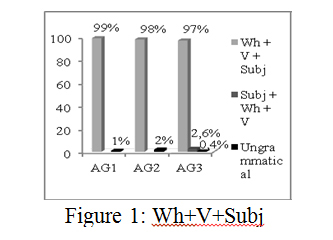
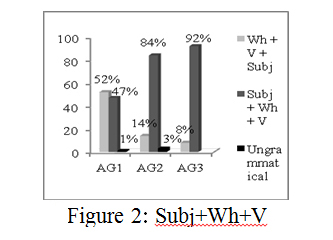
Failing of the two younger groups (AG1 mainly and AG2 at 14% only) to be primed by the topicalized word order condition suggests possible difficulties to move S at a topic position mainly for AG1 (see Papadopoulou, in progress and Papadopoulou & Pavlou, in press) which seems to be resolved as children grow older.
Results above do not refer to the priming effects or not of embu is-(it)-that, since generally priming effects of embu were relatively low across age groups (see again Papadopoulou in progress for an in depth investigation) and the errors children made did not involve any +embu questions.
Overall, children across all age groups made a few errors, only 13 utterances in total corresponding to 1%, 2% and 0.4% for AG1, AG2 and AG3 respectively, for Wh+V+Subj whereas only to 1% and 3% for AG1 and AG2 respectively, for Subj+Wh+V. The majority of the errors made referred to the inability to obey pied-piping conditions (henceforth, (-)Pied Piping) and hence allow wh-subextraction (see example 3 above) resulting in a split DP with the wh-word possibly moved to Spec CP, but with the noun remaining VP-internally resulting in examples like 12 instead of providing the supposed target in 13; this error appeared twice.
(12) *Pco ka arizi i kopela
arizi i kopela
which cleaning-3SG the-NOM girl-NOM
piaton?
plate -ACC
Which plate is the girl cleaning?
(13) Pco piaton ka arizi i
arizi i
which plate-ACC cleaning-3SG the-NOM
kopela?
girl
Which plate is the girl cleaning?
Relatively common -8 items- was the inability to follow the pied piping condition, as in 12, and at the same time change the wh-word in the same sentence as in (14) instead of producing (15).
(14) *I kopela ti troi
the-NOM girl-NOM what eating-3SG
milon?
apple-ACC
Which apple is the girl eating?
(15) I kopela inda milon
the-NOM girl-NOM which apple-ACC
troi?
eating-3SG
Which apple is the girl eating?
Children have also produced sentences with pronouncing both the moved wh-object phrase and the overt in-situ object. They achieved this by moving on the one hand the wh-word to Spec CP but at the same time pronouncing the NP in the VP as in (16) below rather than producing (17).
(16) *O andras ti aniγi
the-NOM man-NOM what opening-3SG ðoron?
present-ACC
Which present is the man opening?
(17) O andras ti anigi?
the-NOM man-NOM what opening-3SG
What is the man opening?
All in all, children participating in SPE-CG were successfully primed by the target wh-question at a very high percentage and produced very few errors. When even the younger children failed to be primed by the topicalised word order they produced grammatically correct questions following the non-topicalised word order. The few errors, that is failure to obey pied-piping conditions as well as pronouncing both the moved wh-word and the object VP internally, are found in higher percentages in the GWG described in the following section where priming was not as strong as in SPE-CG. We turn back to the discussion of the results in section 5 where we also provide a possible explanation of the errors made.
4. GUESS WHAT GAME (GWG)
The error analysis of the second experiment discussed in this paper is the Guess What Game (GWG), which aimed at the extraction of Cypriot-specific wh-phrases in questions (for details see Pavlou 2010b); specifically GWG dealt with D-linked questions in CG. Similar studies on the acquisition of D-linked questions have been reported cross-linguistically. Preschool children were reported to show difficulties in the acquisition of the specific structures (Asproudi 2011) in SMG, and not only. Among others, Stavrakaki (2006) reports omission of NP in which-S and which-O questions in typically developing[10] Greek children. Van Kampens work (1994, 1996, 1997, 2000 and subsequent work) shows that a PF/LF discrepancy in child language is the motivation of errors in D-linked questions, as well as other structures (see van Kampen, 1996 for a detailed discussion and Gavarró & Solà 2004a; Gavarró & Solà 2004b for a different view).
GWG tries to disentangle the acquisition of D-linked wh-questions and the errors appearing in childrens speech when producing the specific structure.
GWGs design controlled childrens responses and led to the production of questions instead of declarative sentences. Initially (see Pavlou 2010a), the hypothesis for the design of the experiment required a rather complex design, which aimed at eliciting the production of 4 types of Cypriot-specific inda-questions as well as subject and object clefts. Block 1 involved a wh-object question with inda mbu (18), a Cypriot-specific wh-word (see inter alias Grohmann, Panagiotidis and Tsiplakou. 2006; Papadopoulou, in progress; Pavlou, 2010b). Blocks 3 and 5 were testing why-questions, but each one with a different wh-word (19 & 20). D-linked questions were given in block 4 with the wh-phrase inda which (21). Blocks 3 and 6 involved subject and object cleft sentences respectively, but these are not discussed here.
(18) Inda mbu vasta o andras?
what holding-3SG the man-NOM
what is the man holding?
(19) Inda mbu fonazi o andras?
why shouting-3SG the man-NOM
Why is the man shouting?
(20) Inda klei o andras?
why crying-3SG the man-NOM
Why is the man crying?
(21) Inda vivlion  kiavazi o
kiavazi o
which book reading-3SG the-NOM andras?
man-NOM
Which book is the man reading?
The only priming input given for the children was limited to the two warm-up items given by the researcher to prompt the child to ask questions. After the warm-up tokens, the child would continue on its own to ask questions without the researcher intervening.
4.1 PARTICIPANTS
Similarly to SPE-CG, data were collected from Greek Cypriot children who were attending either public or private kindergartens in Limassol. The experiment was conducted during kindergarten time, in a one-to-one 15-minute session with the researcher, in the presence of a video-camera. Participants were distributed in four age groups namely, age group 1 (AG1), 3;0-3;11 with mean age 3;8, age group 2 (AG2), 4;0-4;11, with mean age 4;6, age group 3 (AG3) 5;0-5;11 with mean age 5;5 and age group 4 (AG4) 6;0-6;4, with mean age 6;2 (see Table 2).
Table 2: GWG participants
| Age group | Age range | Number of participants | Mean age | Standard deviation | |
| AG1 | 3;0–3;11 | 11 | 3;8 | 3 months | |
| AG2 | 4;0–4;11 | 16 | 4;6 | 2 months | |
| AG3 | 5;0–5;11 | 22 | 5;5 | 3 months | |
| AG4 | 6;0–6;11 | 13 | 6;2 | 3 months |
The first group consisted of eleven children aged 3;0-3;11 and the fourth group had thirteen 6-year-old children. Second and third group were kept distinct even though they could all potentially attend the same class at school namely pre-primary.
4.2 MATERIALS AND DESIGN
Children were expected to ask two supposedly ignorant puppets questions related to pictures presented to them. Each picture had two persons and two objects, with only one person performing an action with one object; the other functioning as a distracter. Motivation for children to ask questions was given since the puppet who gave the correct answer would be awarded a chicken from the coop guarded by a dog and presented to the child before the beginning of the experiment. Eventually, the winner was the one who had more chickens in his/her box.
The experiment was divided in 6 blocks with each block focusing on a certain syntactic structure. The structures targeted were questions with the Cypriot-specific wh-object inda mbu, wh-adjuncts inda and inda mbu why, D(iscourse)-linked wh-phrase inda, subject and object clefts. All were randomized within each block. Each block consisted of two trials in the primed session and four target sentences in the non-primed session.[11]
On the table, there was a coop with chicks, a wooden dog and a file with pictures. The researcher would then say the following:
We are going to play a game with baby lion and baby frog and see who can collect the most chicks. We cannot grab the chicks because they are guarded and the dog will allow us to take the chicks only if we play the game. The one who collects the most chicks will be the winner and will win a prize at the end. You have to ask a question about each picture I show to you. The baby frog and baby lion will try to answer these questions. The one who answers correctly will be a chick given by the dog. If the puppets do not answer correctly, you will get a chick.
In the warm-up tokens, the researcher would provide a model question, but the puppet would refuse to answer because the researcher was an adult and the puppet would only answer questions asked by the child. In the warm up items, the child would re-tell the adults question, but then s/he was told that s/he must ask the questions directly. At the end of each section, the researcher would say you must be tired, let me have a go again now and lets ask the question in a different way. An example of this procedure followed for D-linked questions is summarized below:
(22)
Warm-up 2 Target: Inda aftokinitaki krata i korua?
(Researcher) Which car is the girl holding?
Puppet (To research.): En su milo esena. Pezo mono me mora.
I am not talking to you. I only play with children.
Researcher: Thelis na rotisis esi ton vatraxulin?
(To child) Do you want to ask the baby frog?
Child: Inda aftokinitaki krata I korua?
(To puppet) Which car is the girl holding?
Puppet: To kot?ino.
(To child) The red one.
Researcher: Ate, rota ton gia tuti tin fotografian
(To child) Now, ask baby frog about this picture.
Target 1: Inda doro anii o andras?
(Child) Which present is the man opening?
(Pavlou 2012:43)
The relatively simple procedure followed above for the elicitation of D-linked questions also elicited errors that will be presented below.
4.3 RESULTS
Unlike SPE-CG childrens overall successful targeted production in GWG was generally low and even lower in non-primed sessions (Figure 3 below) with AG1 at 5%, AG2 at 6%, AG3 at 4% and AG4 at 9%.
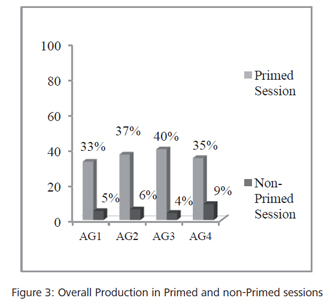
AG1 successfully produced primed questions during the primed section (warm up) at 33% (AG2 at 37%, AG4 at 35%), with AG3 having the highest targeted production at 40%.
Low overall targeted performance was not considered to be a result of the methodology and design. The Cypriot context is taken to be diglossic or bilingual (see section 1 above for references and discussion), so low production was not due to childrens inability to respond to the experiment, but rather to the fact that they used the immediate translation and produced SMG-like wh-phrases instead.
When calculating the production of questions with the SMG-like wh-phrases, similar scores appear in both the primed and non-primed session. This can be explained from the fact that these phrases were not included in the target sentences, but were simply the personal choice of each child. Their production was kept throughout the experiment in all AGs, with AG3 and AG4 scoring higher than the other two AGs (Figure 4 below) and possibly indicating the effects of school environment on language (Grohmann 2011).
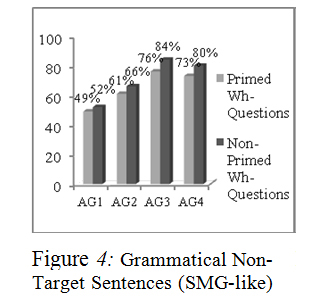
In some instances children failed to produce wh-questions or any other type of question but responded to the game with a declarative sentence. Without engaging into a discussion concerning the different types of different sentences (simple vs. embedded), Figure 5 shows the relatively increased number of these responses in the non-primed sessions.
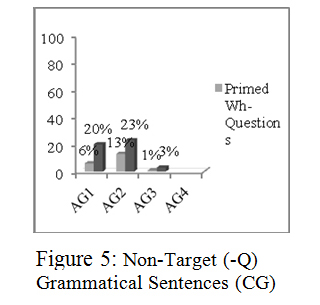
The successful target responses with Cypriot Greek wh-phrases are presented in Figure 6 , where there is an obvious difference between the primed and the non-primed session of the experiment. That is, all age groups produced a CG wh-phrase at 15% and higher with the target wh-phrases in the primd session, which was reduced to 5% and below in the non-primed session.
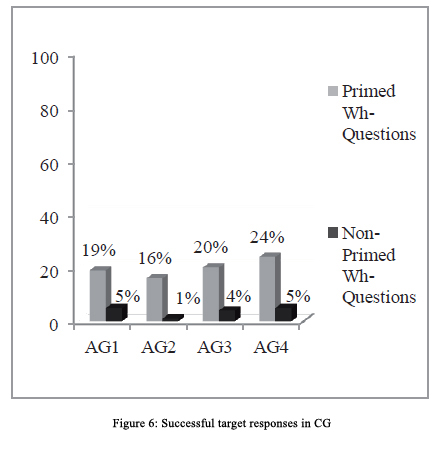
Another group of data, which is also the main point of comparison with the previous experiment, examined error production in D-linked questions. Errors observed are related to pied piping difficulties where the NP was pronounced in its base position and not higher up in the CP (Figure 7). A second pattern observed is the complete omission of the NP from D-linked questions, thus turning them to wh-object questions (Figure 8).
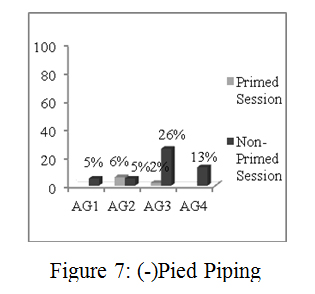
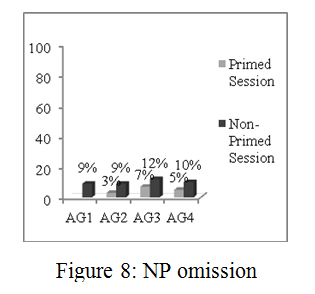
The errors observed in the primed session were fewer rather than the errors observed in the non-primed session. All groups showed lack of movement of the NP in D-linked questions. While the errors identified in the primed sessions were restricted in number and were more frequent in the non-primed session, a great difference was observed in 5-year-old children, where the errors were much more frequent in the non-primed session.
An example of (-) Pied-piping (23) and NP omission (24) respectively is given below:
(23) Ti aftokinitakin krata o
which car-ACC holding.3SG the-NOM
andras?
man-NOM
Which car is the man holding?
(24) Ti krata aftokinitakin o
which holding-3SG car.ACC the-NOM
andras?
man.NOM
Which car is the man holding?
(25) Ti krata o
what/which holding-3SG the-NOM
andras?
man-NOM
What/which is the man holding?
5. DISCUSSION
Childrens syntax can reveal their understanding of adult grammar and the stages which they go through until they reach adult speech. For example, in the errors discussed above in sections 3.3 and 4.3, children appear to make two important errors:
a. move only the operator and strand the noun in complex wh-phrases as in example (12) repeated below as (26)
(26) *Pco ka?arizi i kopela
which cleaning-3SG the-NOM girl-NOM
piaton?
plate-ACC
Which plate is the girl cleaning?
b. move the wh-word to CP, but also pronounce the NP VP-internally as in example (14) repeated below as (27).
(27) * I kopela ti troi
the-NOM girl-NOM what eating-3SG
milon?
apple-ACC
Which apple is the girl eating?
The universality of these errors indicate their importance for language acquisition as it has been found in CG with the current study, in SMG (Stravrakaki, 2006; Asproudi, 2011), in Dutch (van Kampen, 1997), in Catalan (Gavarr?, A. & Sola, 2004a and 2004b) and in English (Chen, Yamane and Snyder 1998), as well as provides some insights to the psychological reality of grammatical positions.
Based on the data taken from the production experiment, childrens errors in D-linked questions are innately-motivated patterns that follow a theoretical reasoning in syntax. It could be argued that when children sub-extract from a wh-NP, they basically choose to move the head of the constituent, which carries any [WH] features. However, an assumption supporting the idea that children target head movement with the errors observed cannot be claimed, since children produced errors with the movement of XPs as subextracted elements from more complex DPs (for a detailed discussion, see Pavlou 2012). Based on the errors that children gave, it is assumed that C has unintepretable [WH] features and looks into its C-command domain and attracts the element that is immediately contained in the maximal projection that contains the relevant feature.
In this way, childrens syntax reveals a fundamental idea of the Minimalist program (Chomsky 1995) and that is the Economy principle and the need to apply the idea of movement in language in the minimalist way. If children need only move whatever is immediately contained in the maximal projection of a relevant feature, then pied-piping should be considered as an over-cost procedure. Based on the predictions above, Pavlou (2012) focused on the idea of supporting MOVE as a syntactic operation, which children understand on the basis of two simple principles: a) Move as little as you can, b) Move as much as you need. The following hypothesis was formulated to predict childrens movement operations based on the data for D-linked wh-questions:
(28) Immediate Move Hypothesis (revised)
Move a iff:
a) a carries the target feature
b) a is immediately contained within the nearest to the probe maximal projection containing the target feature
c) No ß is contained in a such that ß immediately contains the target feature
d) If a forms an XP, then it must immediately contain the target feature
(Pavlou 2012)
Another main point of this paper is the difference in the results based on the priming effect involved. Both experiments used experimental methods to trigger mental representation of grammatical knowledge employed in childrens production. While the success of the priming effect and the completion of all stages was satisfying for SPE-CG, childrens errors were not absent from the overall utterances. Report of a small number of errors shows certain difficulties in movement-related issues in wh-questions that are aligned with a completely different experiment on relevant matters; such as GWG.
Production of Cypriot-specific wh-questions in GWG was relatively low for several reasons. Wh-questions in general were mostly produced with a minor percentage of errors, but production of the targeted wh-phrases was dramatically low. Following the traces of SPE-CG error analysis, the percentages appearing in this experiment track down NP movement and omission as the possible and most common errors Greek Cypriot children make in complex wh-question production.
GWG and SPE-CGs results vary highly suggesting this difference is a result of the different amount of priming provided. In GWG, habituation was applied in the primed session and successfully provided desired results but these immediately decreased as soon as children proceeded to the non-primed session. Children in general completed habituation stage, but dropped primed structures when habituation stage was eliminated. Priming effect is weak and faints away in the GWG experiment suggesting that in order for priming effects to take place strong pushing should be maintained throughout the experiment. Contrastively, all structures were followed as given in SPE-CG because of the high priming effect in the experiment.
The results in SPE-CG appeared to confirm the initial hypothesis with the different age groups following the primed structures of the experiments. GWG on the other hand had only two utterances for each block, which were used as primes. This was considered to be the main reason for the great difference in the results between the two experiments, where most children would drop the primed structures once the priming stages would stop taking place.
Several questions, however, were raised after this comparative study. Even though, the populations of the two experiments were quite similar the difference in wh-question production cannot be ignored. Taking into consideration that the older children participating were 6 year olds, it is assumed that acquisition of wh-questions has taken place long before the time of testing. However, not even the oldest children in the GWG experiment scored as well as 4 year olds in SPE-CG. It appears that maximum pushing for priming of a structure can affect overall performance as previous studies have suggested (Savage et al. 2003, Huttenlocher et al. 2004, 2005) in contrast to minimum pushing for priming, as in GWG. Error production is expected to appear in greater percentages in experiments like GWG, where priming was not so strong and the time of exposure restricted. Concluding, childrens errors can predict their understanding of adult grammar. The degree to which these errors can appear in a set of data followed by experimental tools can be controlled by priming, which is also ideal for calculating the actual pace of learning of specific syntactic structures.
References
Arvaniti, A., (2002), The maintenance of diglossia in Cyprus and the emergence of Cypriot Standard Greek. Ms., University of California, San Diego. [ Links ]
Asproudi, E., (2011), Non-Target Long-Distance Wh-Questions. Crosslinguistic Typological Distinctions in Early L1 Production. Unpublished paper presented at 20th International Symposium on Theoretical and Applied Linguistics (ISTAL 20). Aristotle University of Thessaloniki, Thessaloniki 1-3 April.Bloom, L. [ Links ],
Bock, J.K., Loebell, H., & Morey, R., (1992), From Conceptual Roles to Structural Relations: Bridging the Syntactic cleft. Psychological Review, 99:1, 150-171. [ Links ]
Bock, K., (1986), Syntactic persistence in Language Production. Cognitive Psychology, 18, 355-386. [ Links ]
Branigan, H. P., Pickering, M.J., Cleland, A.A., (2000) Syntactic co-operation in dialogue. Cognition, 75, 13-25. [ Links ]
Branigan, P. H (2007) Priming the interpretation of noun-noun combinations. Journal of Memory and Language, 57, 380-395. [ Links ]
GavarrÓ, A. & Solá, J. (2004a). WH-subextraction in child Catalan. Second Lisbon Meeting on Language Acquisition, Universidade de Lisboa, 1 June. [ Links ]
GavarrÓ, A. & Solá, J. (2004b). Subextraction in Romance interrogatives. Going Romance 2004, Leiden University, 12 April. [ Links ]
Grohmann, K. K. and E. Leivada. To appear, Interface ingredients of dialect design: Bi-x, socio-syntax of development, and the grammar of Cypriot Greek. In Anna Maria Di Sciullo (ed.), Towards a Biolinguistic Understanding of Grammar. Amsterdam: John Benjamins. [ Links ]
Grohmann, K. K., P. Panagiotidis and S. Tsiplakou., (2006), Properties of Wh-Question Formation in Cypriot Greek. 2006. In M. Janse, B. D. Joseph and A. Ralli (eds.), Proceedings of the 2nd International Conference on Modern Greek Dialects and Linguistic Theory (Mytilene, Greece: 30 September–3 October 2004). Patras: University of Patras, 83-98. [ Links ]
Grohmann, K. K & Papadopoulou E., (2011), Question(able) issues in Cypriot Greek. Linguistic Analysis, 37, 1-31. [ Links ]
Grohmann, K. K., (2011), Some Directions for the Systematic Investigation of the Acquisition of Cypriot Greek: A New Perspective on Production Abilities from Object Clitic Placement. In Esther Rinke & Tanja Kupisch, eds. The Development of Grammar: Language Acquisition and Diachronic Change Volume in Honor of Jürgen M. Meisel. (Hamburg Series on Multilingualism 11.) Amsterdam: John Benjamins, 179–203. [ Links ]
Huttenlocher, J. M. Vasilyeva & P.M. Shimpi, (2004), Syntactic priming in young children. Journal of Memory and Language 50, 182–195. [ Links ]
Huttenlocher, J. M. Vasilyeva & P.M. Shimpi, (2007), Syntactic Priming in 3- and 4-Year-Old Children: Evidence for Abstract Representations of Transitive and Dative Forms. Developmental Psychology 43, 1334-1346. [ Links ]
Leivada, E., M. Kambanaros and K. K. Grohmann. (2012), Evaluating teachers grammatical competence in dialect and standard language. Paper to be presented to Bilingual and Multilingual Interaction, ESRC Centre for Research on Bilingualism in Theory & Practice, Bangor University. [ Links ]
Leivada, E., Papadopoulou, E., Pavlou, N., In progress. The Gray Area of Acceptability Judgments: Clefts and Exhaustivity in Cypriot Greek. In Kelechukwu U. Ihemere (ed.), Language Contact: A Multidimensional Perspective. Newcastle-upon-Tyne: Cambridge Scholars Publishing. [ Links ]
Marinis, T. & Van der Lely, H. K. J., (2007), On-line processing of wh-questions in children with G-SLI and typically developing children. International Journal of Language and Communication Disorders. 42(5), 557-582. [ Links ]
Merkin, S. & Wooten, J. (1982), Wh-questions: linguistic factors that contribute to the sequence of acquisition. Child Development 53, 1084–92.Brunetti, L. 2003. A Unification of Focus. Ph.d. diss., University of Florence. [ Links ]
Newton, B., (1972), Cypriot Greek: Its Phonology and Inflections. The Hague: Mouton. [ Links ]
Papadopoulou E. & Pavlou, N., (2010), Movement Difficulties in Cypriot Greek. Poster presented at Language Disorders in Greek 3, European University Cyprus, Nicosia, June 12-13, 2010. [ Links ]
Papadopoulou, E. & Pavlou, N., In press, What I Say, You Say! Illustration of Syntactic Priming in Cypriot Greek. In Kleanthes K. Grohmann, Elena Shelkovaya & Dionysios Zoumbalides (eds.), Linguists of Tomorrow: Selected Papers from the 1st Cyprus Postgraduate Conference in Theoretical and Applied Linguistics. Newcastle-upon-Tyne: Cambridge Scholars Publishing. [ Links ]
Papadopoulou, E., In progress, Acquisition of wh-questions: Evidence from Cypriot Greek. Essex University: Phd dissertation. [ Links ]
Pavlou, N. (2010a), MBU! Wh-objects and true adjuncts of Cypriot Greek. Proceedings of the 4rth Modern Greek Dialects and Linguistic Theory Conference. University of Patras, Department of Philology Linguistic Division (electronic publication). [ Links ]
Pavlou, N., (2010b), Inda mbu, nambu or ine ti pu? Acquiring complex structures in Cypriot Greek. Proceedings of Tutorial and Research Workshop in Experimental Linguistics. Athens: University of Athens, University of Adger & University of Wisconsin-Madison [ Links ]
Pavlou, N., (2012), Pied-piping in wh-questions: What do children say about it? MA dissertation: University of York. [ Links ]
Pavlou, P. and N. Christodoulou, (2001), Bidialectism in Cyprus and its impact on the teaching of Greek as a foreign language. International Journal of Applied Linguistics 11(1), 75-91. [ Links ]
Rowe, C. and Grohmann K. K.., (2012), Testing the state of diglossia in Cyprus: Cypriots, binationals and diglossic shift. Ms., University of Cyprus. [ Links ]
Savage, C., Lieven, E., Theakston, A. & Tomasello, M. (2003), Testing the abstractness of childrens linguistic representations: lexical and structural priming of syntactic constructions in young children. Developmental Science, 6:5, 557-567. [ Links ]
Simeonidis, C. P., (2006), ?st???a t?? ??p??a??? ??a???t??[History of the Cypriot Greek Dialect]. Nicosia: Holy Monastery of Kykkos Centre of Research. [ Links ]
Stavrakaki S., (2006), Developmental perspectives on Specific Language Impairment: Evidence from the production of wh-questions by Greek SLI children over time, Advances in Speech-Language Pathology, 8:4, 384 – 396 [ Links ]
van Kampen, J. (1994). The learnability of the Left Branch Condition. In R. Bok-Bennema & C. Cremers, eds. Linguistics in the Netherlands 1994. 83-94. Amsterdam: John Benjamins. [ Links ]
van Kampen, J. (1996). PF/LF convergence in acquisition. In K. Kusumoto, ed. Proceedings of the NELS 26, 149-163. [ Links ]
van Kampen, J. (1997). First Steps in Wh-movement Delft: Eburon. [ Links ]
van Kampen, J. (2000). Left branch extraction as operator movement: Evidence from child Dutch. In S.M. Powers & C. Hamann, eds. The Acquisition of Scrambling and Clitization. Kluwer, Norwell, 479-503. [ Links ]
Vassiliou, E., (1995), Cypriot as a VOS language. La Trobe Working Papers in Linguistics 8, 135-149. [ Links ]
Yiakoumetti, A., M., Evans, & E. Esch., (2005), Language awareness in a bidialectal setting: The oral performance and language attitudes of urban and rural students in Cyprus. Language Awareness 14(4), 254-260. [ Links ]
Notes
*We would like to thank Sonja Eisenbeiss for the help in constructing SPE-CG, as well as supervising the doctoral research of the second named author, and Kleanthes K. Grohmann for supervising the initial stages of GWG through the Cyprus Acquisition Team (CAT). We also express our gratitude to the audiences at LOT 2010, LDG 3, ISTAL 10 and UMINHO Summer School in Neurolinguistic Approaches to Language for their valuable feedback. We also acknowledge financial support from the Gen-CHILD Project (University of Cyprus, grant number 8037-61017).
[1] This paper reports on work that was prompted by the first named authors research Master dissertation and the second named authors doctoral research.
[2] According to Cyprus constitutions Article 3, Republic of Cyprus has two official languages, that of Greek and Turkish; hence the de jure bilingualism.
[3] From this point onwards Cyprus will be used to refer to the areas of the island that are under the control of the Republic of Cyprus unless stated otherwise.
[4] Results of adult control groups can be found in Pavlou (2012) for GWG and Papadopoulou (in progress) for SPE-CG.
[5] Echo questions allow for the wh-phrase to remain in-situ. For potential differences between echo and non-echo questions in CG see Grohmann & Papadopoulou (2011).
[6] Inda mbu what is-it-that and inda mbu why are considered to be two words according to Pavlou (2010a) whereas Papadopoulou (in progress) argues that it has been grammaticalised as one word. For the purposes of this paper we follow Pavlous approach.
[7] Grohmann et al. (2006) claim that embu can be analyzed through sideward movement in cleft structures whereas Papadopoulou (in progress) suggests that embu has been grammaticalized as a focus particle in present day CG. As supported by Leivada et al. (in progress) embu seems to be in the process of changing (change in progress) stressing that it possibly originated as a cleft but it has now been grammaticalized as a focus particle. Whether embu is analyzed as a cleft or not is not does not contribute to the purpose of the paper hence no further details will be provided.
[8] Further information on which SPE-CG was based can be found in Papadopoulou (in progress), Savage et al (2003) and Huttenlocher et al. (2004, 2007).
[9] See Papadopoulou (in progress) for a detailed analysis of a questionnaire complementing SPE-CG outlining degrees of cypriotness in wh-question word order.
[10] Marinis and van der Lely (2007) present data for this kind of errors in the performance of G-SLI children in gap-filling syntactic dependencies in wh-questions.
[11] Pavlou (2012) provides more details to the design and procedure of the experiment.













